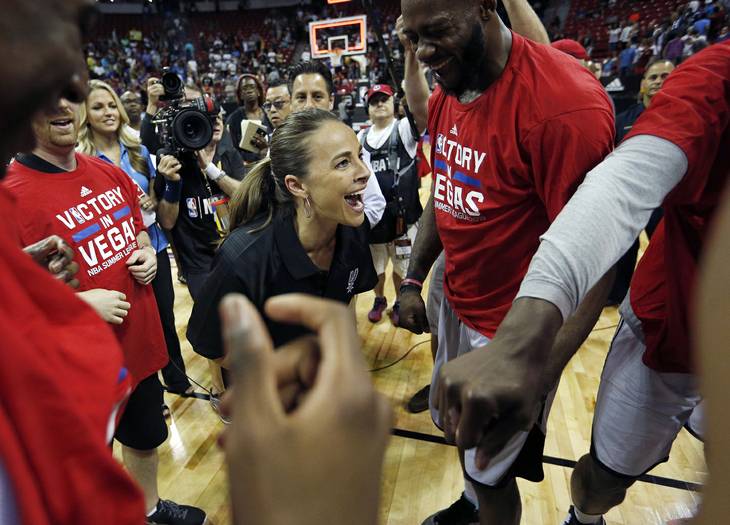What NBA Summer League basketball was and what it has become can be seen on the same day: July 8.
That’s the final day of the Orlando Pro Summer League, one of two smaller basketball events meant only for team personnel and news media, and the first day of the NBA Summer League in Las Vegas, which over a dozen years has blossomed into an 11-day fan extravaganza. Oh, and there’s basketball, too.
“It was just an event that was there for the GMs and the coaches to evaluate their players,” said Las Vegas Events President Pat Christenson. “When they approached us, it was with this idea of taking it to a different level.”
That level looks entirely different from the smaller leagues in Orlando and Utah, and each year it continues to grow. Over the past five, attendance at the Thomas & Mack Center and Cox Pavilion has nearly doubled to more than 100,000. And during what’s usually a slow business month in Las Vegas, Las Vegas Events pegs the total economic impact of last year’s Summer League at $29.5 million, with expectations that the recent growth isn’t a fluke.
“I think it’s just starting,” Christenson said. “I think what’s happened now is, the word has gotten out.”
Bringing the Summer League to Vegas in 2004 was the brainchild of agent Warren LeGarie, who along with sports marketing expert Albert Hall has continued to run what is now a must-attend event for anyone in professional basketball. A few years after the event launched, the NBA started supporting it, facilitating a jump from six teams to 24. And now nearly every NBA general manager and many NBA veterans like LeBron James and James Harden descend on Vegas every July.
“This thing just has so many layers to it now that it’s really become not only a big event but a tool for teams to market to their fans, their sponsors and season-ticket holders,” Hall said.
It’s still built around the 67 games between 24 teams that mostly consist of rookies and young pros trying to make NBA rosters or impress international scouts. But improvements to the games — official uniforms, a tournament format and tests of new officiating technology — pale in comparison to the environment that’s been created.
In the concourse between courts at the Thomas & Mack and Cox you can play Pop-A-Shot, test virtual-reality headsets, get autographs from top rookies, bid on memorabilia to benefit St. Jude Children’s Research Hospital or run into a current NBA player buying a pretzel. And if you hang around late enough you can hold up a sign in the background of The Starters, broadcasting nightly on NBA TV.
“We needed to create a festival atmosphere to where if people want to watch eight games in one day, they don’t feel like it’s dragging,” Hall said.
Contrast that with the practice gyms that house four to 10 teams for Summer Leagues hosted by the Utah Jazz and Orlando Magic, and there’s barely a resemblance. While those events have kept fans locked out, Vegas last year welcomed more than 22,000 out-of-town attendees who helped occupy nearly 35,000 hotel room nights, according to Las Vegas Events.
This year, for the first time, 25 games will appear on ESPN, ESPN2 or ESPNU, while all 67 games will stream on ESPN3 and 30 games will air on NBA TV. After seeing promos for the Vegas event during June’s highly rated NBA Finals, Christenson had no doubt there was plenty more room to grow. “I’m pretty confident that there will be another jump.… I think the NBA promotes this stronger every year.”
Awareness is key for getting people interested in the event, but it’s the experience that has to keep them coming back. Sometimes the games deliver, like in 2010 when undrafted Harvard grad Jeremy Lin first made waves with an impressive performance against No. 1 overall pick John Wall, but the ancillary events must always run smoothly, like the St. Jude Table Tennis Challenge that last year raised $10,000.
“It started as a golf tournament, and it was just too damn hot to play golf,” Hall said, adding that the Atlanta Hawks’ Dennis Schroder and the Oklahoma City Thunder’s Steven Adams brought it on the table.
The Sports Business Classroom, which costs $2,500, is “essentially a training ground for people who want to get into the business of basketball,” Hall said. It’s July 8-13 and features presenters such as head coaches and assistant GMs, as well as a deep dive into the intricacies of the NBA salary cap.
All told, the Summer League has made Vegas the epicenter of professional basketball for a couple of weeks during a month when there isn’t a lot going on in the city. Between the out-of-town fans here to enjoy the atmosphere of the games and the out-of-town millionaires here to see and be seen, the clear winner is the city.
“We really have become a big economic driver,” Hall said. “It’s Vegas’ NBA franchise to an extent.”
